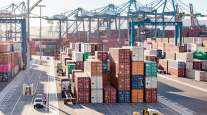TRB Panelists Urge Inclusion of Ports, Rails in Infrastructure Bill

WASHINGTON — Port authorities, trucking companies and shippers are hopeful that the infrastructure bill to be debated in Congress will fund solutions to alleviate congestion in the ocean container freight industry, panelists said Jan. 9 at the Transportation Research Board’s annual meeting here.
Whether it is autonomous driving, freight tracking devices or cleaner trucks, technology is changing the supply chain landscape. However, many also complain that our infrastructure is stuck in the last century.
“We know that freight levels are expected to increase in the future but, at the end of the day, we have congestion now. Manufacturers see congestion as a hidden tax,” said Catie Kawchak, director of infrastructure at the National Association of Manufacturers.
For the agricultural industry, the inability to transport perishable and nonperishable commodities in a timely fashion hinders farmers in the domestic and international markets.
Peter Friedmann, executive director of the Agriculture Transportation Coalition, said that the United States does not have a significant advantage over other countries to supply food to the growing middle class in China or emerging markets in Brazil, India and Vietnam. Therefore, if the country cannot fix the roadblocks to efficient supply chains, it will squander economic opportunities in the coming decades.
“We need to find a way to pay the overtime to longshoremen to operate the night gates at more ports,” he said. “We need to get the cargo off the trucks and take it to inland ports in rural areas, closer to where the agriculture is produced. In the central valley of California, build an inland port so that truck drivers can use their limited hours to the location and rail the containers into the port.”
Peter Friedmann of @TheAgTC talking about how while containerships have grown from 6,000 TEUs to 22,000 TEUs (on order by CMA CGM & MSC), ports haven’t adapted rail and truck presence on dock to meet the new volume pressures. pic.twitter.com/rneNFLEEko — Ari Ashe™ (@ariashe) January 9, 2018
While there has been a coordinated effort to build such facilities on the East Coast, there is only one major inland port in California: Port of Stockton.
Friedmann also urged lawmakers to increase the current 80,000-pound gross weight limit to 105,500 pounds to compete with exporters from Canada, Mexico and countries in Western Europe.
The National Association of Manufacturers asked the U.S. Department of Transportation in 2017 to study whether to raise the total to 91,000 pounds while also advocating for twin 33-foot trailers.
Walter Kemmsies, economist and chief strategist for Jones Lang LaSalle’s U.S. Ports, Airports and Global Infrastructure Group, said that while trade agreements need some “sprucing up,” infrastructure also must be updated to reflect the new world economy in which the United States must export as much as import.
“We need to have an economic objective to an infrastructure bill. If we have a national economic objective, the public sector will pull together to support it. But we need a clear policy objective about what we’re trying to accomplish for the economy by making this investment,” Kemmsies said.
Port of Long Beach Executive Director Mario Cordero highlighted the opportunities to ship plastic resins and other petrochemical byproducts in the coming years. Imports account for about 51% of the business at the Port of Long Beach, and exports are only about 23% with the remaining amount being empty containers.
“I would like to see an emphasis on infrastructure as it relates to rail,” Cordero said. “It’s not just about the major [Class I] railroads, it’s about the inner harbor infrastructure within our ports. In Long Beach, we’re putting a full-court press on finding ways to enhance our on-dock rail to reduce congestion on the highways.”
The effort is especially important in Southern California because containerships have grown exponentially in recent years. In the early 2000s, large vessels held 6,000 industry-standard 20-foot equivalent units, or TEUs, based on historical data. Around 2012, big vessels held 9,000 TEUs. A couple years ago, steamship lines commissioned new 18,000-TEU vessels. Less than four months ago, CMA CGM and Mediterranean Shipping Co. ordered the first 22,000-TEU vessels.




